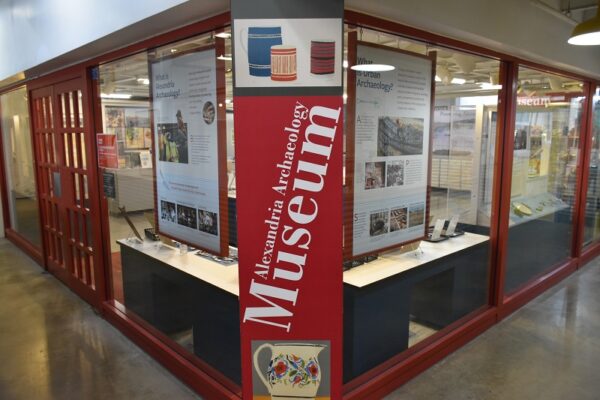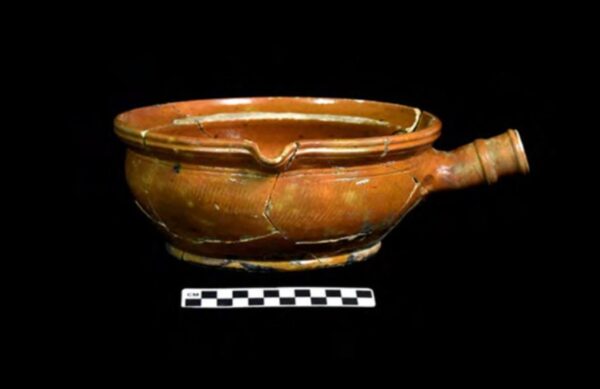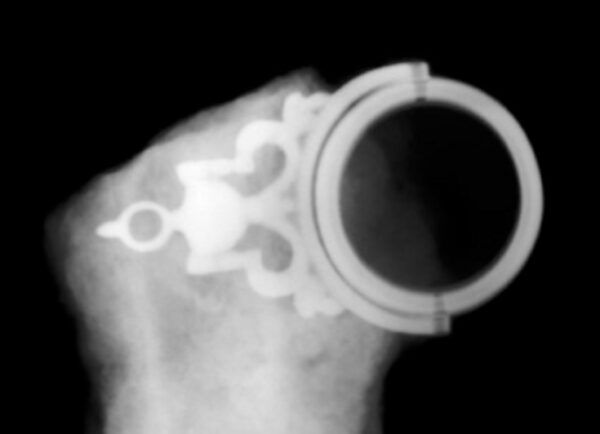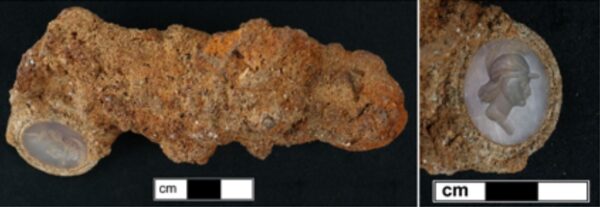
A new exhibit in the Alexandria Archaeology Museum (on the third floor of the Torpedo Factory, 105 N. Union Street) highlights a “microcosm of the city” on Lee Street.
The new exhibit dives through the layers of history at one site in Old Town, along with glimpses at a few other waterfront sites.
The origins of the exhibit go back to 1997 when a permit to construct an underground garage at the corner of North Lee and Queen Streets opened the floodgates for city archeologists.
“The staff immediately recognized that the project afforded a unique opportunity to study the development of one block within the context of the history of the City and its waterfront,” a staff report from 1999 said.
The report said the excavation became a tourist attraction in its own right.
“Archeological excavations… caught the attention of thousands of people for a six week period in August and September 1997,” the report said. “Long forgotten by most people, very tangible ruins and artifacts were revealed through a systemic archeological excavation as backhoes, shovels and trowels peeled back layers of soil and layers of time. The town’s history was literally unearthed before people’s eyes.”
The new exhibit puts the artifacts discovered by the expedition on permanent display. According to a release from the Office of Historic Alexandria:
On June 9th the Alexandria Archaeology Museum opened a new permanent archaeology exhibit called A Community Digs its Past: The Lee Street Site. Cases and panels display artifacts and reveal the archaeological process and the history of Alexandria as seen through the lens of the Lee Street Site (archaeological site number 44AX180) and several other waterfront sites. The exhibit answers questions like: what is urban archaeology; what did Alexandria look like in the past; and what do archaeologists do? The exhibition was made possible by a grant from Historic Alexandria Foundation and is the cornerstone of the museum.

While the prospect of buried treasure in the back yard sounds appealing, Alexandria leaders say amateur treasure hunting is hindering historic preservation efforts.
At a City Council meeting last night, Mayor Justin Wilson said the Alexandria Archaeological Commission has expressed concerns about items taken from homes in Old Town that belong in a museum.
“Folks are going around in Old Town and offering to excavate privies folks have on their property,” Wilson said. “As a city that values professional archaeology and what we might discover, interpret and protect from archaeological digs, I know the commission is very concerned about the potential impacts of this backyard archaeology that can occur.”
City Archaeologist Eleanor Breen said in recent years, non-professional “bottle diggers” have targeted homes with back yards in Old Town. Former outhouses are a prime area of focus for archaeological work, featuring many items discarded that help tell the story of everyday life in a given period of history.
Breen said the city has been doing outreach in-person at local farmers’ markets and virtual outreach via the city website to try to connect homeowners with proper resources. The city also has a 311 network
“It’s a difficult conversation with property owners because they’re excited, but we want to make sure we protect these historic artifacts,” Wilson said. “We want to make sure folks are doing this wisely.”
Council member Kirk McPike noted that the 311 report system for “sinkhole on property” could make Alexandria the first city in the country with a virtual reporting system focused on historical bathrooms.
“It’s a privy category,” Wilson said. “If ever there’s a community that has that down, it’s ours.”
Image via AlexArchaeology/Twitter

An x-ray treatment of an artifact found at Robinson Terminal South has revealed more details about an artifact stuck into a strip of corrupted iron alloy.
The much smaller artifact came from the same area as the buried ships found in 2018. The artifact is a watch fob, a popular 18th and 19th-century accessory, but only part of the original piece was visible. A report by conservator Arianna Johnston from the Maryland Archeological Conservation Laboratory highlighted what their lab learned with further study.
“The chalcedony stone oval is flat on both faces, engraved on one side with a figure and set into a metal frame,” Johnston said in the report. “Watch fobs were worn at the waist, and while the watch may be tucked into a pocket, the accessories would hang from chains on display.”
The displays could include seals, initials, family crests or other decorations. Only a face was visible when the artifact came to the lab and the size and shape of the full fob was unclear, but Johnston said they used x-rays to help tell more of the story.

“The radiograph shows a complete watch fob accessory with delicate openwork along the top of its frame,” Johnston wrote. “The bright contrast in the radiograph indicates a denser metal than the surrounding corrosion and iron; the metal is presumed to be predominately copper alloy, though gilding may be present.”
Johnston said the radiograph also shows pins at the top and bottom of the frame, which indicate that the stone could spin. The x-ray also showed that there’s no chain or jump ring attached to the iron, so how it would have hung off the owner is unclear.
“The conservation treatment for this artifact is ongoing,” Johnston wrote. “The next steps include freeing the fob from its iron alloy companion and reducing the corrosion using mechanical cleaning methods.”
Some artifacts from the Robinson Landing Site (44AX235) are being conserved at the Maryland Archaeological Conservation (MAC) Lab. The MAC Lab’s latest Curator’s Choice blogpost highlights an engraved watch fob. Find out how X-rays guided the treatment https://t.co/eWF6QBmUJS
— AlexVA Archaeology (@AlexArchaeology) February 9, 2022
The Office of Historic Alexandria announced this morning (Tuesday) that it will be shutting down immediately and taking most of the city’s museums with it.
“Due to a shortage of staff and volunteers as well as low attendance, the Office of Historic Alexandria (OHA) has decided to close its sites to the public starting March 17,” the OHA said in a statement. “Public programs at OHA sites through April 12 have been canceled or rescheduled.”
The OHA noted in the statement that the office is reaching out to anyone who made reservations for events or tours at the locations to reschedule those.
“Due to the changing nature of the situation, we are not announcing a reopening date at this time and will provide updates on our website,” the OHA said.
According to the statement, the following locations will be closed:
- Alexandria Archaeology Museum
- Alexandria Black History Museum
- Alexandria’s History Museum at The Lyceum
- Archives and Records Center
- Fort Ward Museum and Historic Site
- Freedom House Museum
- Friendship Firehouse Museum
- Gadsby’s Tavern Museum
- Stabler-Leadbeater Apothecary Museum
The OHA shutdown is part of a broader sweep of closures across the city, from restaurants to lodgings, as many in the city are self-quarantining.
(Updated at 3:20 p.m.) While Alexandria heads out on ghosts tours for Halloween, local archaeologists are busy scouting for secret burials under two historic cemeteries.
Archeologists with the city’s Office of Historic Alexandria are working to pinpoint where coffins and headstones may have been swallowed by the changing landscaping in the Penny Hill and Douglass cemeteries as they plan drainage maintenance for the sites.
“In a couple places you see the very tippy tops of headstones just barely peeking above the dirt and you realize that there’s an entire headstone sunken in 2-3 feet. So you look around and go ‘Oh my god this entire cemetery is slowly sinking into the ground,'” Benjamin Skolnik, an archeologist with the city, told ALXnow of the issues facing the two cemeteries.
“A lot of the markers were probably made of wood and have since decayed and evaporated into the mists of time,” he said, adding that others buried in the Penny Hill potter’s field often couldn’t afford a marker.
Fixing the drainage issues at both sites causing could mean digging ditches — and right now that would be impossible without disrupting lost burial sites.
Penny Hill was founded in 1796 but start records only date back to 1912. Those records indicate 906 people were buried in the last century, but today cemetery is an empty, grassy field.
And at Douglass, where records indicate the first person was buried in 1895, there are about 650 standing headstones, but over 1900 names recorded in burial records.
“There’s three times the number of people written in the cemeteries as there are standing headstones, so the question is where is everybody?” said Skolnik.
This summer, the state awarded Alexandria a $10,500 grant to study what graves could be underneath the grass at both cemeteries. Now the survey work is underway as teams of archeologists rove the grounds with ground-penetrating radar (the same kind used to find dinosaurs) and electrical conductivity meters to identify burials by the metal hinges on caskets, the shafts dug to bury caskets, as well as skeletal remains or headstones.
Initial data from Douglass confirms some areas with no standing stones do have graves underneath, and in some cases, more than one grave.
“We know that they were selling what they referred to as “half-graves” which is basically that you stack them,” explained Skolnik. “The first one goes down 8 feet. The next one goes down 4 feet.”
The surveys haven’t gone without a hitch, however. Yesterday (Tuesday’s) rain storm cancelled one day of work, and nearby utilities can interfere with the equipment.
“We ran into a small problem on Saturday when we started our survey at Penny Hill,” said Skolnik. “The southeast corner of Penny Hill is right next to a power substation [which] was playing havoc with the sensitive instruments.”
The surveys are in addition to the Alexandria archaeologists’ other responsibilities, including examining possible remains and objects buried under development sites — work that led to the excavation and reconstruction of several long-buried ships.
“It’s probably not a surprise that there are lot of archeology resources in Alexandria,” said Skolnik. “There’s a lot going on under the ground.”

